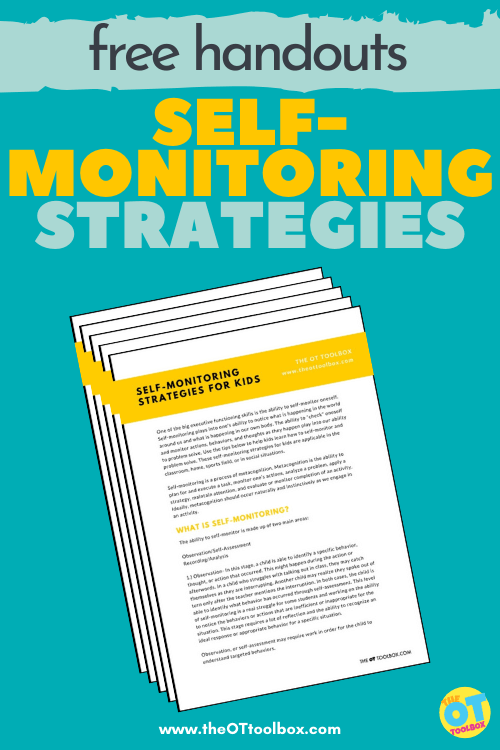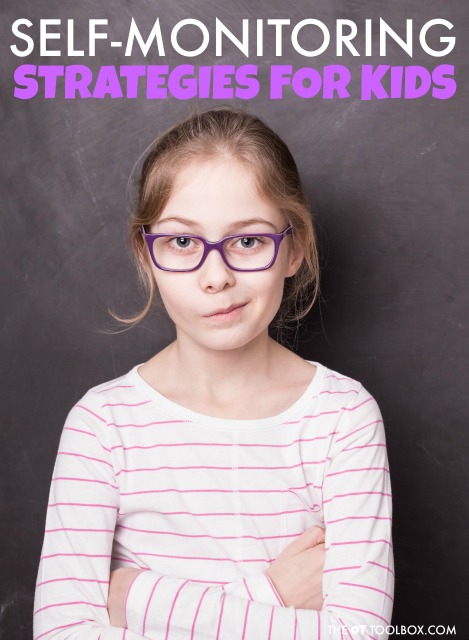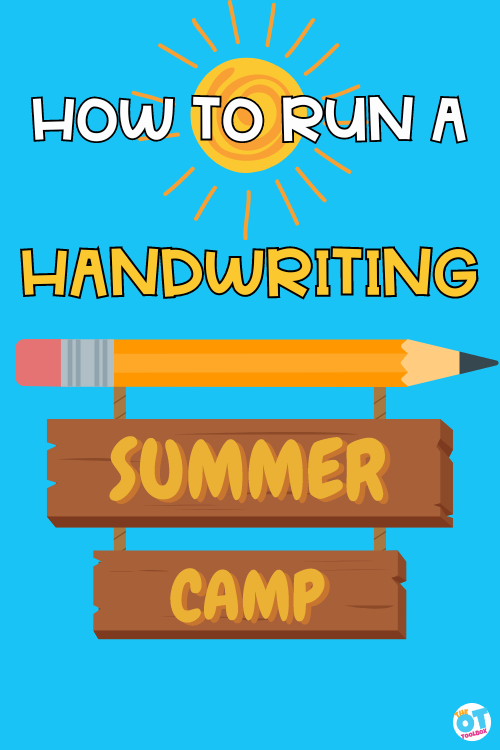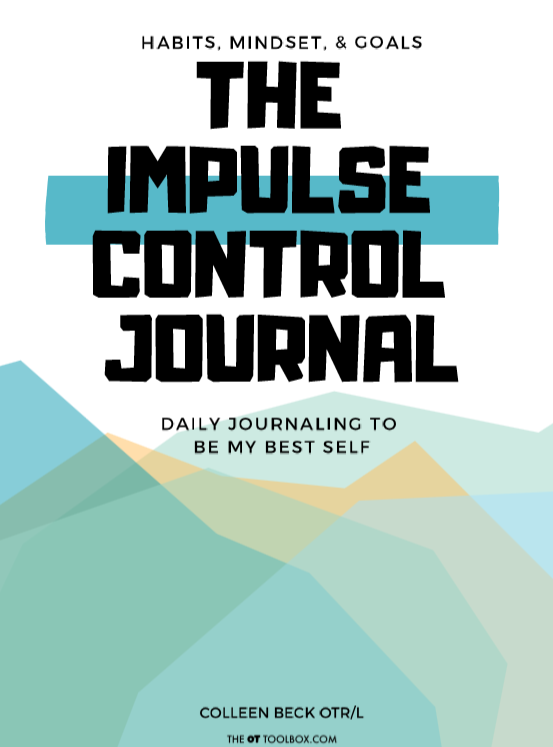One of the big executive functioning skills is the ability to self-monitor oneself. Self-monitoring strategies play a part in the ability to notice what is happening in the world around us and what is happening in our own body. The ability to “check” oneself and monitor actions, behaviors, and thoughts as they happen play into our ability to problem solve. Use the tips below to help kids learn how to self-monitor and problem solve. These self-monitoring strategies for kids are applicable in the classroom, home, sports field, or in social situations.

As a related resources, try these self-reflection activities for kids. You’ll also love these other free handouts for executive functioning skills: Organization Handouts.

Related read: Here are more executive functioning resources to fill your therapy toolbox!
What is self-monitoring
Self-monitoring is a process of metacognition. Metacognition is the ability to plan for and execute a task, monitor one’s actions, analyze a problem, apply a strategy, maintain attention, and evaluate or monitor completion of an activity. Ideally, metacognition should occur naturally and instinctively as we engage in an activity.
The ability to self-monitor is made up of two main areas:
1.) Observation- In this stage, a child is able to identify a specific behavior, thought, or action that occurred. This might happen during the action or afterwards.
In a child who struggles with talking out in class, they may catch themselves as they are interrupting. Another child may realize they spoke out of turn only after the teacher mentions the interruption.
In both cases, the child is able to identify what behavior has occurred through self-assessment. This level of self-monitoring is a real struggle for some students and working on the ability to notice the behaviors or actions that are inefficient or inappropriate for the situation. The ability to observe and recognize behaviors or actions is a skill, and that self-monitoring ability requires a lot of reflection, as well as the ability to recognize an ideal response or appropriate behavior for a specific situation.
2.) Recording- This stage of self-monitoring is a means for moving from an awareness of actions and behaviors to function. In the recording stage of self-monitoring, children are able to note their actions and make changes based on what happened in specific situations.
Having a set of strategies in place to address self-regulation needs, attention needs, or emotional supports is beneficial for use in the moment. Jotting down deviances of targeted behavior can help kids to become more aware of what happened in a specific situation and how they can make adjustments in the future to avoid specific behaviors, or how they can use accommodations and self-regulation tools to respond and react more appropriately.
3.) Look at what needs addressed to get to a future that is desired- So often, kids know they are making poor choices, but don’t know how to stop the routine of those poor choices. If they can use introspection to identify how and what they are feeling and why, they can respond to those choices with a plan in place.
This letter to future self is a great tool to identify areas of change and to start breaking down goals. Follow up with our goal ladder as another strategy to make step by step progress toward that future visualization.
Self-Monitoring Strategies
In talking about self-monitoring skills, let’s first discuss what exactly self-monitoring is and what it means for kids to self-monitor their actions, thoughts, and behaviors.
Observation, or self-assessment may require work in order for the child to understand targeted behaviors.
Recording or measurement of actions can occur through several methods:
- Checklists
- Parent/Teacher/Student communication sheets (where the child inputs behaviors throughout the day)
- Journaling in a notebook or a tool such as the Impulse Control Journal
- Data collection sheets
- Frequency collection forms
- Self-graphing
Self-Monitoring Examples
- Lists of appropriate actions or behaviors
- Simple strategies to impact self-control
- Visual cues
- Verbal cues
- Reminder notes
- Goal setting
- Journaling in a notebook or a tool such as the Impulse Control Journal
- Coaching
- Role-playing practice
- Self-talk
- Modeling from peers
The goal of this stage is to get students to move from a teacher/parent/therapist/adult support of self-assessment to a self-assessment status where the child identifies behaviors and actions that are off-target.
A child’s ability to stay organized can make a big impact on self-monitoring. Use the organization activities and strategies identified here.
Why is Self-Monitoring important?
When children self-monitor their actions and thoughts, so many areas are developed and progressed:
- Attention
- Behavior
- Problem-solving abilities
- Hindsight
- Foresight
- Persistence
- Shift
You can see how each of the executive functioning skills play into the ability to self-monitor and how self-monitoring skills play into the development and use of each of the other executive functioning skills.
The ability to self-monitor actions, behaviors, thoughts impacts learning, mindset, social and emotional skills, and functional participation in everyday tasks.
Self-Monitoring Impacts Function
There are also functional skills that are developed and improved through self-monitoring:
- Learning
- Communication
- Behavior
- Task initiation
- Task completion
- Social-emotional interaction
- Follow-through on learned skills
Self-Monitoring Strategies
Below, you will find additional self-monitoring strategies that can help children with the ability to identify and self-assess and self-adjust behaviors that may occur within the classroom, home, or other environment.
There are many examples of self-monitoring strategies that can be used to help students develop this skill. One technique is to use text-to-self connections, which involves asking students to relate new information to their own experiences or prior knowledge.
This can help them to better understand the material and make connections that will improve their memory and retention. Another strategy is to focus on executive function skills, such as time management, organization, and planning. By teaching students how to self-monitor these skills, they can become more independent and successful in their academic and personal lives.
These strategies should be viewed as supports that can be used independently by the child following instruction and input to teach strategy methods.
- Make an outline for writing tasks, homework assignments, or multi-step assignments in order to keep the child on task.
- Utilize a self-monitoring schedule- Ask the child to stop and self-check their actions, behaviors, or thoughts to make sure they are on-task.
- Try an index card or other visual reminder on desks for a list of appropriate behaviors.
- Use social stories to teach appropriate actions and reactions to specific situations in the home or classroom.
- Incorporate a schedule of self-regulation strategies to address sensory, attention, and focusing needs. A sensory diet can help with this.
- Teach the child to check and recheck- Teach children to stop and check and then re-check their behaviors.
- Teach the child self-talk strategies.
- Teach students to look at their finished assignment from their teacher’s eyes. This can help them have an outside view of completed work or actions in the classroom and adjust as appropriate.
- Sensory or coping strategies scheduled throughout the day for sensory input or movement breaks.
- Use a timer for scheduled self-assessment and self-reflection of behaviors or actions and recording of data.
- Work toward fading self-monitoring visual and physical cues as well as data collection means.
- Teach the child to journal experiences. The Impulse Control Journal can be a helpful tool for children who are able to write or dictate to an adult.
Related read– Find many strategies and activities to boost attention in kids here.
Self-Monitoring Handout
Want to access this article as a printable PDF to use as a handout? Use the printable version in education to parents, teachers, therapists, and other professionals. Simply print off the printable version and add it to your therapy toolbox.
Note: In order to access this file, you will need to enter your email address. This allows us to send the PDF directly to your email. This is a 5 page printable self-monitoring strategy outline for educating those who work with kids with self-monitoring skills in kids.
The Impulse Control Journal…a printable resource for helping kids strategize executive functioning skill development. When saying “calm down” just isn’t enough…
When a child is easily “triggered” and seems to melt down at any sign of loud noises or excitement…
When you need help or a starting point to teach kids self-regulation strategies…
When you are struggling to motivate or redirect a child without causing a meltdown…
When you’re struggling to help kids explore their emotions, develop self-regulation and coping skills, manage and reflect on their emotions, identify their emotions, and more as they grow…
Grab the Impulse Control Journal to build organizational strategies, planning, prioritization, habits, and mindset in kids.
self-monitoring
Self-monitoring is an essential skill for individuals to develop, especially those working with executive functioning skills. It involves paying attention to one’s own behavior, thoughts, and emotions, and adjusting them as necessary. Self-monitoring can help individuals identify their strengths and weaknesses, recognize patterns of behavior that may be problematic, and develop strategies for improving performance. By using self-monitoring strategies to address behavior and academic issues, professionals and educators can help students become more self-aware and develop greater self-control.
Step-by-step self-monitoring
Step-by-step teaching of self-monitoring is an effective way to help students learn this skill. It begins with identifying the behavior or skill that needs to be monitored, setting specific goals for improvement, and teaching the student how to keep track of their progress.
This can be done using a self-monitoring checklist, which outlines the steps involved in the process and provides a clear roadmap for success. With practice, students can become more proficient at using self-monitoring strategies to track their own behavior and improve their academic and social skills.
For students with ADHD, a self-monitoring checklist can be a helpful tool. It can help them stay focused and on task, monitor their own behavior, and track their progress towards goals.
The checklist can include items like:
- staying on task
- following instructions
- completing assignments on time
By checking off items on the list, students can see their progress and feel a sense of accomplishment. It can also be used to provide feedback to parents and teachers, who can provide support and encouragement as needed.
Self-monitoring can also be used as an intervention for students who are struggling with behavior or academic issues. By identifying the problem behavior or skill and teaching the student how to monitor and adjust it, professionals and educators can help the student improve their performance and develop greater self-control. Self-monitoring skills can be used in a variety of settings, including the classroom, home, and community.
There are many different self-monitoring tools available that can help students develop this skill. These tools can include visual aids, like charts and checklists, or digital tools, like apps and software programs.
The key is to find the right tool for the individual student and to provide ongoing support and encouragement as they develop their self-monitoring skills. With practice and persistence, individuals can become more self-aware, improve their behavior and academic performance, and develop greater confidence and independence.

Colleen Beck, OTR/L has been an occupational therapist since 2000, working in school-based, hand therapy, outpatient peds, EI, and SNF. Colleen created The OT Toolbox to inspire therapists, teachers, and parents with easy and fun tools to help children thrive. Read her story about going from an OT making $3/hour (after paying for kids’ childcare) to a full-time OT resource creator for millions of readers. Want to collaborate? Send an email to contact@theottoolbox.com.







